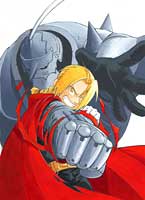|
|
|||||||
|
|
|||||||
|
|||||||
| | Web Japan >> | Trends in Japan >> | Arts & Entertainment >> | Full Metal Fantasy | |
|
FULL METAL FANTASY Hagaren's Manga and Anime Success Spreads to Other Media (May 26, 2005) The world of Japanese manga and anime has produced one hit after another. Anime fans can be found in a wide range of age groups, and recently the comic and anime titled Hagane no Renkinjutsushi (Fullmetal Alchemist), popularly known as "Hagaren," has gained a huge following among children and adults alike. Hagaren began as a manga and has spawned not only a TV anime series but also a festival, a wide range of merchandise, and a movie set to hit cinema screens in the summer of 2005. Hagaren is the latest example of a story whose success transcends the manga and anime market to have an impact on other popular entertainment fields. Synergy of Manga and Anime A TV anime series of Hagaren began in October 2003, and thanks to the success of the series Hagaren has become popular even with those who were not familiar with the original manga. In many families, parents have become hooked on the anime while viewing it with their children. Since the series was first aired, sales of Hagaren paperbacks have increased tenfold. The anime has also driven more people to read the serialized comic. Although the anime series was discontinued in 2004, rebroadcasts began in April 2005, and the monthly comic serial still continues. A set of DVDs containing all 51 episodes of the anime series has sold nearly one million copies. Riding this momentum, the series also began being airing in the United States in November 2004. Hagaren Movie Coming Soon In March 2005, meanwhile, a Hagaren attraction was unveiled at the Universal Studios Japan (USJ) theme park in Osaka (now it is closed for a limited time only). USJ, which features attractions based primarily on Hollywood movies like Spiderman and E.T., opened in 2001. In order to attract more visitors, the park decided to introduce popular characters from Japan alongside those from Hollywood. USJ's Hagaren attraction has generated excitement among anime fans. Hagaren fans are also looking forward to July 2005, because this is the month that an original full-length Hagaren movie is scheduled to be released. Popular Japanese band L'Arc-en-Ciel has been chosen to produce the movie's theme song. Examples such as Pokemon show that when a manga or anime story captures the public's imagination, the potential for success in the popular entertainment industry is almost limitless. Following Hagaren's anime debut in the United States, and with the story set to make its first big-screen appearance soon, there is no end in sight to Hagaren fever. Copyright (c) 2005 Web Japan. Edited by Japan Echo Inc. based on domestic Japanese news sources. Articles presented here are offered for reference purposes and do not necessarily represent the policy or views of the Japanese Government. |
THE WORLD OF JAPANESE ANIME (April 5, 2004) MANGA GOES INTERNATIONAL (January 7, 2003) MANGA GURU'S CREATIONS GO LIVE (July 16, 2002) |
|
|




